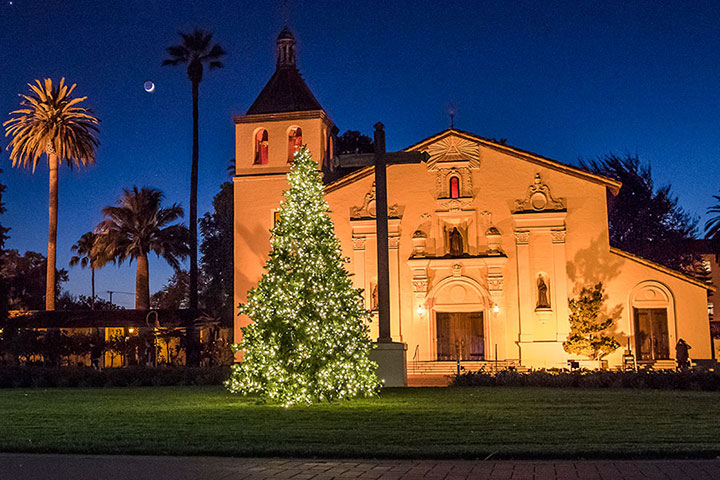
The Lens of Faith
John Michael Reyes ’09, M.Div. ’13
The visual and spiritual richness of the Christmas and holiday season rises in part from celebrating faith in a way that is meaningful. Santa Clara University is a community rooted in the Jesuit, Catholic tradition, but sees an importance in listening to and respecting those who celebrate their faith differently.
Even Catholic traditions can be approached in a number of ways. The Mission Church, the spiritual center of campus, has served as a stage for many different celebrations of Catholic faith on campus.
For example, over the past two years, Campus Ministry and the student multicultural center club BARKADA have collaborated on celebrating a Filipino tradition called Simbang Gabi (“Church at Night”), a nine-day celebration leading up to Christmas. The stunning visuals of this celebration make quite an impact.
As people walk into the church, their eyes are drawn to flickering lanterns called parols (star lanterns). These Christmas symbols are an expression of seeking out moments of light and hope when life’s darkness seems overwhelming. Hanging from the church’s sconces are parols made by the students, and it’s heartwarming to see students admire each other’s artistic creations. The entire celebration is a reminder that our cultural traditions tie person to person and community to community.
Another event, the Celebration of La Virgín de Guadalupe, has been performed for over 20 years at SCU. Energetic matachines (dancers) in colorful attire rhythmically dance in front of the Mission, some with braziers of burning copal incense, welcoming attendees. Once inside, the entire church becomes a stage and the audience, sitting in the round, is swept into each scene.
A poignant sight comes at the end of the play, when roses drop from Juan Diego’s tilma (cloak). Throughout the audience, parents hold up their children, directing their attention towards the actor in amazement. Elsewhere, elderly women and men whisper prayers while shedding a tear. These moments and reflections are touching—they show how important La virgencita is to the community who has gathered. As someone with a different cultural understanding of Our Lady of Guadalupe, the celebration provides me with a glimpse of how we can appreciate the power of other traditions and be transformed by understanding and fellowship.
By looking through the lens through which others experience faith, communities are expanded and strengthened. We leave these Christmas moments with a reminder to see ourselves in others: experiencing faith, cultivating friendships, and building hope for a shared future.